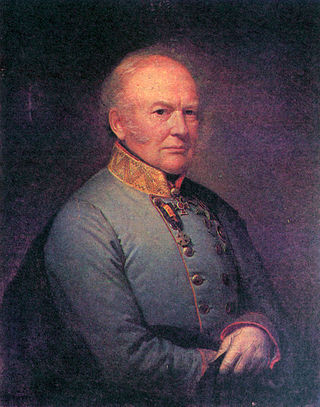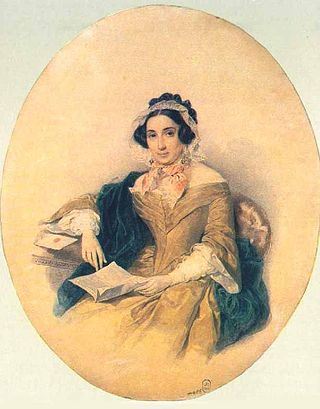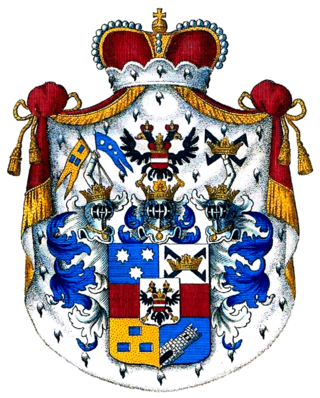
Eugénie de Montijo was Empress of the French from her marriage to Napoleon III on 30 January 1853 until he was overthrown on 4 September 1870. From 28 July to 4 September 1870, she was the de facto head of state of France.

Bernardine Eugénie Désirée Clary was Queen of Sweden and Norway from 5 February 1818 to 8 March 1844 as the wife of King Charles XIV John. Charles John was a French general and founder of the House of Bernadotte. Désirée Clary, the mother of Oscar I, was the one-time fiancée of Napoleon Bonaparte. Her name was officially changed in Sweden to Desideria although she did not use that name.

The Austrian nobility is a status group that was officially abolished in 1919 after the fall of Austria-Hungary. Austria's system of nobility was very similar to that of Germany, as both countries were previously part of the Holy Roman Empire (962–1806).

Kazan Cathedral or Kazanskiy Kafedralniy Sobor, also known as the Cathedral of Our Lady of Kazan, is a cathedral of the Russian Orthodox Church on the Nevsky Prospekt in Saint Petersburg. It is dedicated to Our Lady of Kazan, one of the most venerated icons in Russia.
The Herrengasse is a street in Vienna, located in the first district Innere Stadt.

The Egmont Palace, also sometimes known as the Arenberg Palace, is a neoclassical palace in Brussels, Belgium. It was originally built between 1548 and 1560 for Countess Françoise of Luxembourg and Count Lamoral of Egmont, though its appearance was heavily modified in the 18th and 19th centuries. It was partly destroyed by fire in 1892, after which it was once again reconstructed. Nowadays, it is used by the Belgian Ministry of Foreign Affairs for receptions, as a guest house and conference centre.

Grand Duchess Maria Nikolaevna of Russia was a daughter of Emperor Nicholas I of Russia, and sister of Alexander II. In 1839 she married Maximilian, Duke of Leuchtenberg. She was an art collector and President of the Imperial Academy of Arts in Saint Petersburg.

Karl Ludwig, Count of Ficquelmont was an Austrian aristocrat, statesman and Field marshal of the Austrian Imperial army of French noble origin.

Count Manfred von Clary-Aldringen was an Austro-Hungarian nobleman and statesman. He served as the 16th Minister-President of Cisleithania.

Siegfried Graf von Clary und Aldringen was an Austro-Hungarian diplomat during the time before World War I.

The de Ficquelmont family is a noble family from Lorraine dating back to the 14th century whose filiation is established with Henry de Ficquelmont, a knight who died before 1386.

Dorothea "Dolly" de Ficquelmont, born Countess Dorothea von Tiesenhausen, was a Russian writer and salonist. A granddaughter of the Russian war hero General Prince Kutuzov, she was a Russian aristocrat of German Baltic origin, and later a member of the Austrian nobility as the wife of Count Karl Ludwig von Ficquelmont.

Count Berend Gregor Ferdinand von Tiesenhausen was a Russian noble and military officer of German Baltic origin.

The House of Clary und Aldringen, also known as Clary-Aldringen, is one of the most prominent Austro-Hungarian princely families. Originally from Friuli, Northern Italy, one branch of the family moved to the County of Tyrol around 1500 and to the Kingdom of Bohemia around 1600, where it became one of the leading families of the Bohemian nobility. It produced several notable Austro-Hungarian statesmen, military officers and diplomats.

Princess Catherine Bagration was a Russian princess, married to the general prince Peter Bagration. She was known for her beauty, love affairs and unconventional behavior.

The Palazzo Clary is a Late Renaissance Venetian palace facing the Giudecca Canal alongside the fondamenta Zattere by the ponte longo in Venice's Dorsoduro. It was originally built in the 17th century for a Venetian noble family. In the early 19th century, the palazzo was known as Palazzo Clary, named after the prince Clary-Aldringen who bought it. The neighboring building is Palazzo Giustinian Recanati.

The Saltykov Mansion is a Neoclassical palace situated between Palace Embankment and Millionnaya Street in Saint Petersburg, Russia. It was built to the design of Giacomo Quarenghi in the 1780s. A few months before her death, Catherine the Great presented the edifice to Prince Nikolai Saltykov, the tutor of her eldest grandsons.

Countess Eleonore Batthyány-Strattmann was a Viennese court lady. The daughter of Imperial Court Chancellor Count Theodor Heinrich von Strattmann und Peuerbach, she was married to Hungarian nobleman and Ban of Croatia Ádám II Batthyány until his early death in 1703. For more than twenty years after becoming a widow she was Prince Eugene of Savoy confidante, companion and some have suggested Éminence grise. One of the most respected women in 18th century Viennese society, she was known as 'Beautiful Lori'.

Countess Ekaterina Mikhailovna Ribopierre was the wife of diplomat and chief chamberlain Alexander Ivanovich Ribeaupierre, and a cavalry lady of the Order of Saint Catherine and State Lady of the court, and recipient of the Order of Queen Maria Luisa.
























